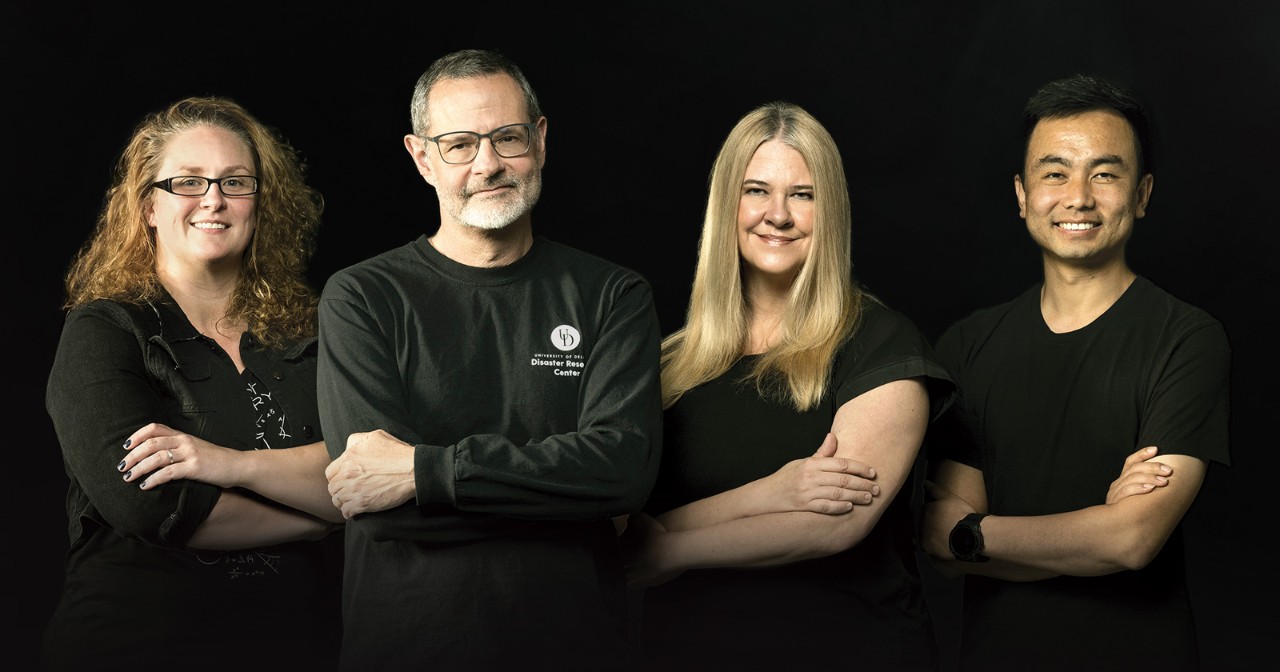


Masters of Disaster
UD's world-renowned center works to change lives for the better
January 13, 2025
We’re all bracing for catastrophe.
As the country witnessed with the devastating wildfires in Los Angeles, as well as back-to-back hurricanes Milton and Helene last fall, storms and other natural disasters are growing more intense. Cyberattacks are increasingly malicious. And, according to experts, future pandemics are practically a given. No longer is it a niche set of doomsday preppers who are stockpiling canned beans or investing in so-called bug-out bags.
But before you retreat to the nearest bunker, take heart. A growing field is dedicated to improving society’s disaster resilience and response. And UD’s globally renowned Disaster Research Center (DRC)—the first unit of its kind in the world—leads these efforts.
“There’s a misperception that people get into this field for the adrenaline of storm chasing or running toward a crisis,” says Tricia Wachtendorf, AS99, 06PHD, professor of sociology and co-director of the DRC. “But people are drawn to disaster research because they care about making a difference, and they want to change lives for the better. That’s what this enterprise is all about.”

Sixty years ago, in the midst of the Cold War, governments wanted to know how people might behave in the event of a nuclear showdown. The U.S. Office of Civil Defense tasked three sociologists at Ohio State University with researching this topic, but their purview quickly expanded to include hazards of all kinds: storms, wildfires, industrial accidents, epidemics, landslides and other large-scale catastrophes. In 1985, the center moved to UD, and Blue Hen researchers have been helping communities develop and refine disaster mitigation and response strategies ever since. (The DRC’s reputation is so stellar, Josh Kelly, AS10, UD’s associate director of emergency management, once landed a job related to disaster research in Texas simply because he was sporting a University of Delaware tee shirt.)
DRC experts also devote much energy to nurturing a new generation of disaster science scholars and practitioners—the University offers an undergraduate concentration in emergency and environmental management as well as a graduate degree in disaster science and management, and thousands of alumni have moved through these programs to impactful careers. Consider Megan Hewitt, AS16, who serves the U.S. Navy’s nuclear deterrence mission (no pressure), or Spencer Schargorodski, AS11, who advises the director of the Federal Emergency Management Agency (FEMA) on strategy. He recently met with the Pope about climate change related activity.
“Because of DRC’s all-star team, the information at FEMA and other major emergency management organizations is current—never stale—and we’re able to help as many community members as possible,” he says. (Indeed, FEMA policy documents cite DRC research.)

There is much that sets the center apart from other institutions with a similar mission. For starters: boots-on-the-ground work. Researchers have conducted more than 700 field studies in disaster zones around the world, from 9/11 to the Indian Ocean tsunamis, and they’ve collected data about, say, the important role of citizen responders or the coordination of relief agencies. Sarah DeYoung, a professor of sociology and criminal justice who researches maternal-fetal health in disasters, has seen everything from Hawaiian lava flows to post-earthquake Nepal.
“You experience the environment the way the survivors do—from a sensory perspective,” she says. “You actually smell the smoke from a Canadian wildfire, and you get a better idea of the trauma these people experience day in and day out—just breathing. It adds a layer of empathy.”

This human-centered approach is key to the DRC philosophy—experts here examine disasters through a sociological lens. This means they’re focused not merely on the behavior of a given tsunami or hurricane, but on the behavior of the people and communities affected. They’re interested in how disasters expose values and vulnerabilities, how they exacerbate inequalities, and how factors like race, gender and class impact decision making during emergent situations. (Consider that affordable housing units are not typically built to the same codes as storm-resilient structures, or that evacuation planning doesn’t always account for those with mobility issues.) Then, the experts translate this information out of academic-speak and into a language emergency managers and other practitioners can actually understand.
“People think of disasters as the great equalizer, but this simply isn’t true—people don’t experience these events the same way,” says Angela Gladwell, BSPA98M, an acting deputy associate administrator for FEMA. “If we want to reduce suffering, we need to examine a variety of perspectives, and that’s what the DRC does so well.”
Success is due largely to the center’s collaborative nature, which brings together engineers, geologists, hydrologists, psychologists, anthropologists, sociologists and other kinds of ‘ologists’ to tackle society’s greatest challenges. One example is the DRC project CHEER, or the Coastal Hazards, Equity, Economic Prosperity and Resilience hub. A $16.5 million project funded by the National Science Foundation, the five-year goal is to develop a software tool that will help waterfront communities navigate a complex question: How can they reduce climate change related risks while still prospering financially—and how can they do it in ways that are fair for everyone, from mansions to mobile homes?

“It’s pretty big-picture and ambitious,” acknowledges project lead Rachel Davidson, professor of civil and environmental engineering. “But I believe DRC is one of the best places in the world to do this type of interdisciplinary work. A lot of people talk about this kind of thing, but we’re actually synthesizing ideas.”
Still, the road ahead will be stormy, and lay individuals would be forgiven for questioning whether even the most skilled of disaster professionals are up for the challenge. Is it realistic to believe society can handle the crises likely coming our way? Maybe we’ll all succumb to disaster—or disaster fatigue—and retreat, defeated, to those backyard bunkers after all.
Or maybe not.
“One of the things you learn doing this work is that, despite calamity and chaos, people survive and thrive,” says James Kendra, professor of public policy and administration and co-director of the DRC. “The human capacity for ingenuity in the face of crisis—the human capacity for hope—is inspirational.”
Contact Us
Have a UDaily story idea?
Contact us at ocm@udel.edu
Members of the press
Contact us at 302-831-NEWS or visit the Media Relations website


